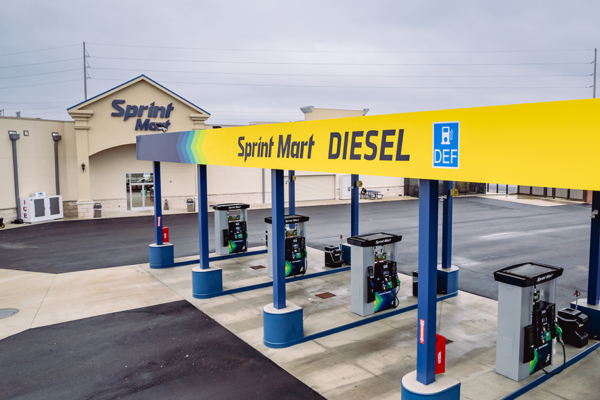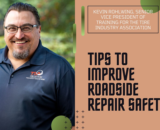Article created for the digital issue of the NATSO Foundation’s magazine
Truck stops and travel centers feature multiple profit centers and amenities; plus, customers want to get in and out quickly.
Travel centers are like five or six stores in one. In addition to the convenience store side, they have expanded food services, trucker services and oftentimes have truck repair, truck washes and scales.
Within a location you’ll likely have a convenience store, quick-service food offerings, restrooms and a fuel desk for professional drivers. You may also choose to offer showers, laundry facilities, truck and/or tire service, and truck scales.
All these factors make designing new travel centers a very complex endeavor.
Gather these key architecture and design considerations for a travel center new build from the NATSO Foundation’s Travel Center and Truck Stop New Build Toolkit.
It Starts with the Customer Journey
“The interior and exterior design of the store is a critical element in getting customers in and out quickly. Think long and hard about how customers move throughout the location as well as the parking lot and fuel islands,” said Darren Schulte, NATSO’s vice president of membership.
“The customer experience starts when they come on site and then you guide them to the services they need through the site design,” said Mike Lawshe, president of the design firm Paragon Solutions, a NATSO Chairman’s Circle Member. “We’re looking at it much more holistically and creating a customer journey pathway for every customer type. When the intentionality of that seeps into design, you have a better design.”
Knowing Your Customer
The first step to determining the architecture and design you want is to identify who you’re trying to attract then determining which customer types are the most important. From there, you can create a hierarchy to guide the design. Since every site and demographic is different, every solution is different.
Schulte has been an avid proponent of knowing your customer.
Professional drivers are often pressed for time. Landscapers or pickups towing trailers want to be able to maneuver their vehicles in and out easily. Women value restrooms.
“If we want female customers, we can’t build small restrooms. If we want RV customers, we have to have auto diesel at every pump and make it easy for vehicles to maneuver,” Schulte said. “If we want the professional truck driver to come in and spend money with us, we don’t want the commercial fuel lanes to be too far from the building. If we want EV pickup trucks, we better have EV pull through because those drivers won’t be unhooking their trailers.”
NATSO member Sean Register, owner of Port Fuel Center in Port Wentworth, Georgia, focused on attracting drivers servicing the port nearby. “There are about 12,000 truck moves within a half of a mile from our facility,” he said.
Port drivers are focused on how many trips they make through the port each day. Register has designed his location to give those drivers the speed they need and added features to improve their experience, including augmented checkout counters, kiosk ordering and displays that monitor traffic at the port. He said drivers have told him that they are able to make extra runs to the port because of the time they save at the travel center.
Getting People Inside
In today’s operating environment, nearly every customer type is in a hurry and wants a seamless experience, which you can help achieve through design. “How easy do you make it to get food and pay for fuel? If you’re trying to maximize customers’ time and their potential spend with you, you make it easy,” Schulte said.
Multiple entrances can create efficiency for customers. “We are getting in a situation where stores get bigger,” he said.
You’ll want to create parking near the entry points to encourage drivers to move from the gas and diesel lanes to free up the lanes for other drivers.
Directing the Flow of Customers
While traditionally operators have positioned some key profit centers and services deep inside of the store, that can backfire if drivers are in a hurry. Schulte recommends you place restrooms near the entrance, which can actually encourage customers to shop. “If you make it hard for people to get to the restroom and they’re short on time, that means they’re going to spend less money with you because they have less time to shop,” he said.
Positioning food near the front can also benefit your customers, and it is important to keep grab-and-go items well stocked.
No matter where customers go first, their experience at the checkout counter is typically the last interaction they have at a location. Anytime a line forms, it can not only delay customers but also give them a negative perception of the location. “Knowing that your customers are always in a rush, you have to think about your store and how it is laid out and how people maneuver,” Schulte said.
Self-checkouts can help speed customers through, and customers are more and more accepting of the technology today. Some even seem to prefer it. When visiting locations that have cashiers and cashier-less options, such as ordering kiosks, self-checkouts, vending machines and in-app ordering, 7% of drivers taking part in NATSO Services’ 2023 professional driver buying behavior survey said they always choose the cashier-less option and 20% said they sometimes choose it.
NATSO members with self-checkout have reported that 15-30% of their customers, including professional driver and four-wheel traffic, are using it. Most of the self-checkout equipment is located either nearby the traditional forecourt point of sale counter or directly adjacent it.
Those locations that seem to have the most success with self-checkout create displays and offer impulse items around the registers. Self-checkout has to be as nice, appealing and inviting to the customer as checkout lanes with cashiers.
Even moving just some customers out of a line can improve the transaction time for those who prefer to interact with a cashier.
Focusing on Food
“You have to know who your customers are. It is hard to support a full-service restaurant if only one-third of your customers say that is what they want,” Schulte said, explaining that low customer counts, labor shortages and an increasing need for rapid service make sit-down restaurants a challenge for many operators.
The types of food you plan to offer will influence your design. Grab-and-go sales have increased as drivers are increasingly pressed for time, and locations tend to be the most successful with innovative, quality food offerings that customers can access quickly.
Schulte said some locations are taking out sit-down dining and reinventing the food service experience. “We are seeing increased demand for drive through service and pick-up and delivery, both in food service in general and in our industry,” Schulte said.
Jessica Williams, CEO of Food Forward Thinking, explained that drivers may simply be looking for a place to sit
and rest, good service, and a general feeling of care and connection from a real person, which can provide some of the perks of a sit-down restaurant without the resources a sit-down facility requires.
For example, employees could walk around the location offering to refill drinks, clear the trash, or check in
and say hello.
Drivers are also picking up multiple meals at a time. For example, a driver who stops in to pick up a breakfast sandwich will also pick up lunch if it is something that holds well.
Some locations are allowing customers to order food via an app, either ahead of time or when they’re fueling. “You have to start thinking that way,” Schulte said. “I think there is going to come a time where we get to the car hop or the truck hop idea.”
From a design perspective, you can add short-term parking to make it easy for drivers to come in and get food or create a delivery area where employees could take food out to the curb.
Inside the location, quick-serve and self-serve areas can get busy and little changes, such as moving condiments away from the main food counters to help disperse customers, can make areas look less crowded and more inviting.
Operators should also think about the parking lot. NATSO Services’ research into driver’s shopping and buying habits shows that drivers don’t want to leave the cab. Partnering with a third- party to provide deliveries or creating an in-house delivery option can help meet those drivers’ needs. Another way to serve drivers who don’t want the interaction and would rather eat offsite are to offer ways to order ahead or to have hot grab-and-go boxes ready and waiting.
Assessing Labor Needs
Given the labor challenges, it is important to factor labor needs into your design. “If we put a 20-door cooler in
a travel center, how much time, energy and cost is associated with stocking the cooler? Could we have an 11-door cooler but focused on the right merchandise? Operations and construction have to work together when designing a location,” Schulte said.
Other solutions to cut down on labor needs could include using desert scaping rather than grass, locating the trash close to the building to save staff time, and designing restrooms so they don’t have to be blocked completely for cleaning. “It could be like an airport where you block off one side at a time,” Schulte said.
Knowing Yourself
In addition to knowing who you plan to serve, you need to know who you are. For example, a location may want to be known for low fuel prices, outstanding food service or speed.
Creating that unique experience is an important way to stand out, especially as more and more customers seek out experiential retail. We have several NATSO members that have found unique ways to establish themselves as a destination.
Oasis Travel Center in Robertsdale, Alabama, has created specific themes for its profit centersto create a fun environment. The restaurant, the Derailed Diner, is one of the most talked about parts of the travel center. On the outside, it looks like a train crashed into the building. Inside there is a full-size school bus and a train caboose. All the décor and collateral is related to travel and space craft. The diner gets a lot of attention on social media.
Cashiers at Oasis Travel Center work inside of a giant pirate ship. The area has a pirate and shipping theme. There are toys, stuffed animals and books all related to the ocean. An old International Truck that has been transformed into the location’s fuel desk.
Racine Petro in Sturtevant, Wisconsin, placed its grill inside an Airstream, which sends food via baskets to the bar, indoor seating area and rooftop patio on the second floor. “The food trolley travels 45 feet at an angle and travels to the bar area. It is very visible, and it is also practical,” said Michael Willkomm, co-owner and president of Willkomm Companies. “It was a fun way to do something different.”
Quick Trip is known for its speed-of-service, and each of QuikTrip’s locations, from inside the store to the fuel islands, has been designed and formatted to get people in and out quickly.
“Thought has gone into how someone gets a candy bar, visits the cooler or pours a cup of coffee,” Schulte said, adding that the focus on speed starts with the company’s culture. “Employees know service is key, everyone is cross-trained, and QuikTrip has strategically positioned staff within the location to ensure people can get through quickly.”
The important thing is not to try to replicate others without adding your own influence.
Planning Restrooms
Restrooms are one of the most important features at a truck stop or travel center. “The design of your restrooms is super critical. How you lay them out and the size is really important,” Schulte said. “Nothing is more negative than anyone traveling having to wait in line for the restroom.”
The restroom process for men is typically faster than it is for women, which can dictate the amount of space you assign to each. “If you build a travel center and your ladies’ room isn’t as large or larger than the men’s room, you’re creating problems,” Schulte said.
While a line at a restroom might irritate customers, nothing is more frustrating than a travel center restroom being closed for cleaning. Schulte recommends designing a restroom with two sides and separate entries for each side so you can close one side off to clean it while leaving the other side open.
Are you embarking on a new travel center build?
(A 2023 poll from NATSO members found that 63 percent are ‘likely’ to invest in a rebuild or remodel during the next 12 to 18 months. To help NATSO member travel center operators develop new locations, the NATSO Foundation has articles like this one, created a toolkit and offered a workshop at NATSO Connect. The NATSO Foundation’s Travel Center and Truck Stop New Build Toolkit was created to help travel center operators develop new locations. Access the NATSO Foundation’s Travel Center and Truck Stop New Build Toolkit here.
The toolkit was made possible with support from Zippin.
// This article was created for Stop Watch magazine, the magazine of the NATSO Foundation. The NATSO Foundation is the research, education and public outreach subsidiary of NATSO, Inc. The NATSO Foundation provides programs and products to strengthen travel plazas’ ability to meet the traveling public's needs through improved operational performance and business planning. Visit www.natsofoundation.org for more information. (Donate to the NATSO Foundation here.)
Subscribe to Updates
NATSO provides a breadth of information created to strengthen travel plazas’ ability to meet the needs of the travelling public in an age of disruption. This includes knowledge filled blog posts, articles and publications. If you would like to receive a digest of blog post and articles directly in your inbox, please provide your name, email and the frequency of the updates you want to receive the email digest.






